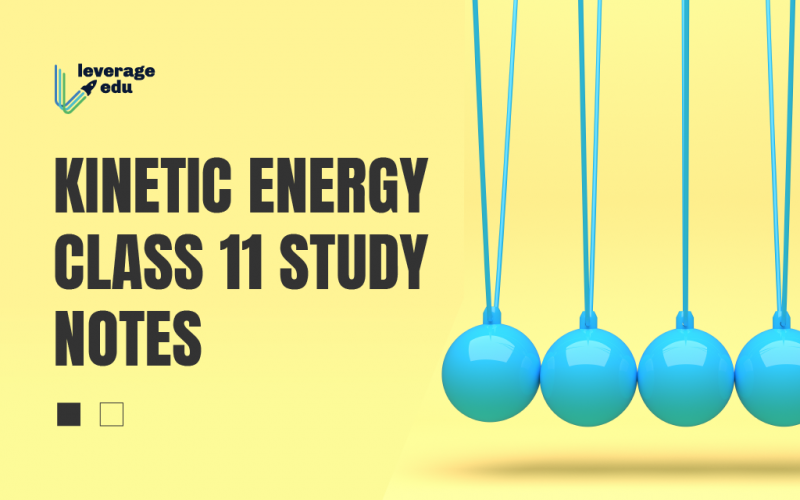Kinetic energy is a form of energy which helps an object to remain in motion. When an object is applied net force, that object gains speed and eventually, gains kinetic energy. Kinetic theory is a chapter in class 11th physics. The chapter is an important chapter as well as a scoring one. Read this blog further to understand kinetic energy class 11.
Must Read: Class 11 Physics Chapter 3 – Motion in a Straight Line
This Blog Includes:
Kinetic Theory
According to Kinetic energy class 11, Kinetic theory basically explains the behaviour of the gases due to the assumption that gas consists of atoms or molecules. Kinetic theory of gases explainsS the random movement of molecules. This theory gives a plausible explanation for all these-
- Explains specific heat capacities of gases in a correct manner
- Kinetic theory remains consistent with gas laws and Avagadro’s hypothesis.
- Explains the molecular interpretation of temperature as well as pressure.
Also Read: Work, Energy and Power Class 11
Nature of Matter
Kinetic energy class 11 talks about the nature of matter. Many scientists drew up different hypotheses which states that everything in this entire universe is made up of atoms.
- Dalton’s Atomic Theory- This theory states that matter is made up of molecules which are made up of atoms. This theory of Dalton is also known as molecular theory of matter. This theory of Dalton was a success as it explained that atomic structure can be viewed by an electron microscope.
- Avogadro’s Law- it explains that equal volumes of gases at equal volumes of temperature have the same number of molecules.
Behaviour of Gases
Next in kinetic energy class 11, we move on to the behavior of gases. All the gases at high temperatures & low pressures have a relationship between their temperature, pressure and volume.
PV=KT
P= Pressure
V= Volume
K=Constant
T=Temperature
K=NKb
N= Number of Molecules
Kb=Boltzmann Constant
So, PV/NT= Kb (constant)
This explains that the relation is satisfied by all gases at high temperature and low pressures.
Ideal Gas
Ideal gas also known as perfect gas is a gas which obeys all the gas laws i.e. which satisfies the perfect gas equation at all temperatures and pressures.
Characteristics of ideal gas:
- Ideal gas consists of large number of identical molecules
- Molecules obey law of motion and move in random motion.
- Molecule of ideal gases is a point mass with no geometrical dimensions.
Check Out: Body Fluids And Circulation Class 11 Study Notes
Laws of Gas
According to kinetic energy class 11, there are certain laws of gas. They are mentioned below.
Boyle’s Law- Boyle’s law is also called Marriott’s Law which explains a relation between compression and expansion of the gas at a particular temperature. This law was formulated by Robert Boyle in 1662 who was a great physicist of his time. This law is derived from the Kinetic theory of gases assuming an ideal gas.
This law states that the volume of a fixed mass of gas is inversely proportional to the pressure of the gas considering that the temperature of the gas is kept constant.
PV= Constant
Charle’s Law– Charle’s Law of gases states that the volume of a given mass of gas is directly proportional to the absolute temperature of the gas, considering that the pressure of the gas continues to remain constant. Charle’s law is also commonly called the law of volumes.
V/T= a constant
Gay Lussac’s Law- Joseph Gay-Lussac was a French chemist who discovered the relationship between the pressure of the gas and its temperature. Gay Lussac’s Law of gases states that the pressure of a given mass of gas is directly proportional to its temperature considering the volume is constant.
P/T= a constant
Avagadro’s Law- Avagadro’s gas law also known as Avogadro’s hypothesis states that equal volumes of different gases present under similar temperature conditions contain equal numbers of molecules.
Graham’s Law of Diffusion of Gases- Graham’s law of diffusion of gases was given by Thomas Graham and it states diffusion as a phenomenon and that the ratio of rates of diffusion of two gases is the square root of the inverse ratio of their molar masses.
The rate of diffusion of gaseous substance is inversely proportional to square root of its molar mass.
Explore: Class 11 Cell Structure and Function
Kinetic Interpretation of Temperature
According to kinetic energy class 11, average kinetic energy of gas molecules of ideal gas is directly proportional to absolute temperature of the molecules. Thus, temperature of the gas is a measure of average kinetic energy.
This interpretation of temperature states that average kinetic energy U is 0 at T.
Mean Free Path- According to the kinetic theory of gases, mean free path is defined as the average distance that the particle travels between collisions as well as other moving particles.
Degrees of Freedom- Degree of freedom can be explained as the number of independent coordinates required for in order to help in specifying the position f a molecule.
Explore: Class 11 Physics Chapter 7 – System of Particles and Rotational Motion
This was all about Kinetic energy class 11. We hope that these notes helped you boost your preparation process. We wish you all the best for all your upcoming examinations. Hoping to pursue a career in physics? Get in touch with our Leverage Edu experts to get complete assistance in choosing the right course and get admission to your dream university. Sign up for a free session with us now!

 One app for all your study abroad needs
One app for all your study abroad needs






















 45,000+ students trusted us with their dreams. Take the first step today!
45,000+ students trusted us with their dreams. Take the first step today!


